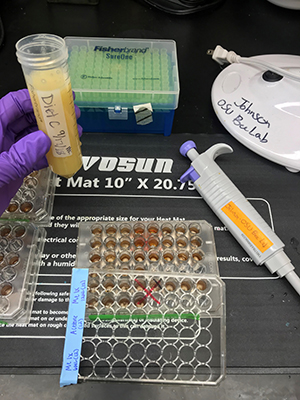
Approximately 1.5 million honey bee colonies are currently used to pollinate ~950,000 acres of nut-producing almond trees in California. Since the estimated number of colonies in the United States is ~2.6 million according to the USDA National Agricultural Statistics Service, that means nearly 60% of the country’s managed honey bees are flying around in California almond orchards each February.
So, if there was a time and place to ensure that bees were not exposed to harmful levels of pesticides, almond pollination in California would be high on the list. But is that the case? This is the topic for our eighteenth “Notes from the Lab,” where we highlight “Combined toxicity of insecticides and fungicides applied to California almond orchards to honey bee larvae and adults,” written by Andrea Wade and colleagues and published in the journal Insects [10:20 (2019)].
Wade and colleagues’ study was motivated by widespread beekeeper concern about potentially harmful pesticide exposure during almond pollination in 2014. Reportedly, upwards of 40% of colonies in almond orchards experienced adult honey bee deaths or dead and deformed brood, and 20% of colonies were completely dead. Data from the California Pesticide Information Portal indicated that several pesticides were applied during almond bloom, including the insecticides chlorantraniliprole, methoxyfenozide, and difubenzuron, and the fungicides propiconazole, iprodione, boscalid, and pyraclostrobin.
The insecticides, which are applied during bloom to control the peach twig borer (Anarsia lineatella), work by targeting insect developmental processes and muscle function. In 2014, each insecticide was labeled for application in almonds during bloom due to low acute toxicity to honey bees. However, several studies have found sublethal impacts of these insecticides on honey bees, including impaired learning, reduced brood production, and reduced survival of adult workers and immature queens.
Fungicides are commonly applied to almond and nearly all other U.S. crops during bloom to control a wide variety of fungal plant pathogens. Due to their low acute toxicity to bees, fungicides are generally assumed to pose low risk. However, recent studies have found that several fungicides can synergize with insecticides and enhance their toxicity, especially when applied together via a tank-mix.
To test the potential impact of the insecticides and fungicide-insecticide combinations that bees could be exposed to while pollinating California almond, Wade and colleagues performed an elegant series of pesticide effects bioassays on honey bee larvae and adults. First, they dosed larval food with concentrations of each fungicide, insecticide, or fungicide-insecticide combination that could be expected given field application rates by growers (2% by volume). Larvae were allowed to develop until pupation and adult emergence was recorded. Second, a dose-response curve for adult worker bees was developed to assess when synergism between propiconazole and chlorantraniliprole occurred at various concentrations of chlorantraniliprole.
So, what did they find? Did any of the insecticides or fungicides impact larval mortality on their own? Yes. None of the fungicides impacted larval mortality on their own, nor did the insecticides chlorantraniliprole or methoxyfenozide. However, only 11% of larvae exposed to the insecticide diflubenzuron survived to adulthood, a nearly 4-fold reduction in survival compared to controls. While previous studies have found low acute toxicity of diflubenzuron to adult honey bees, this substantial impact on larvae mirrors ….


